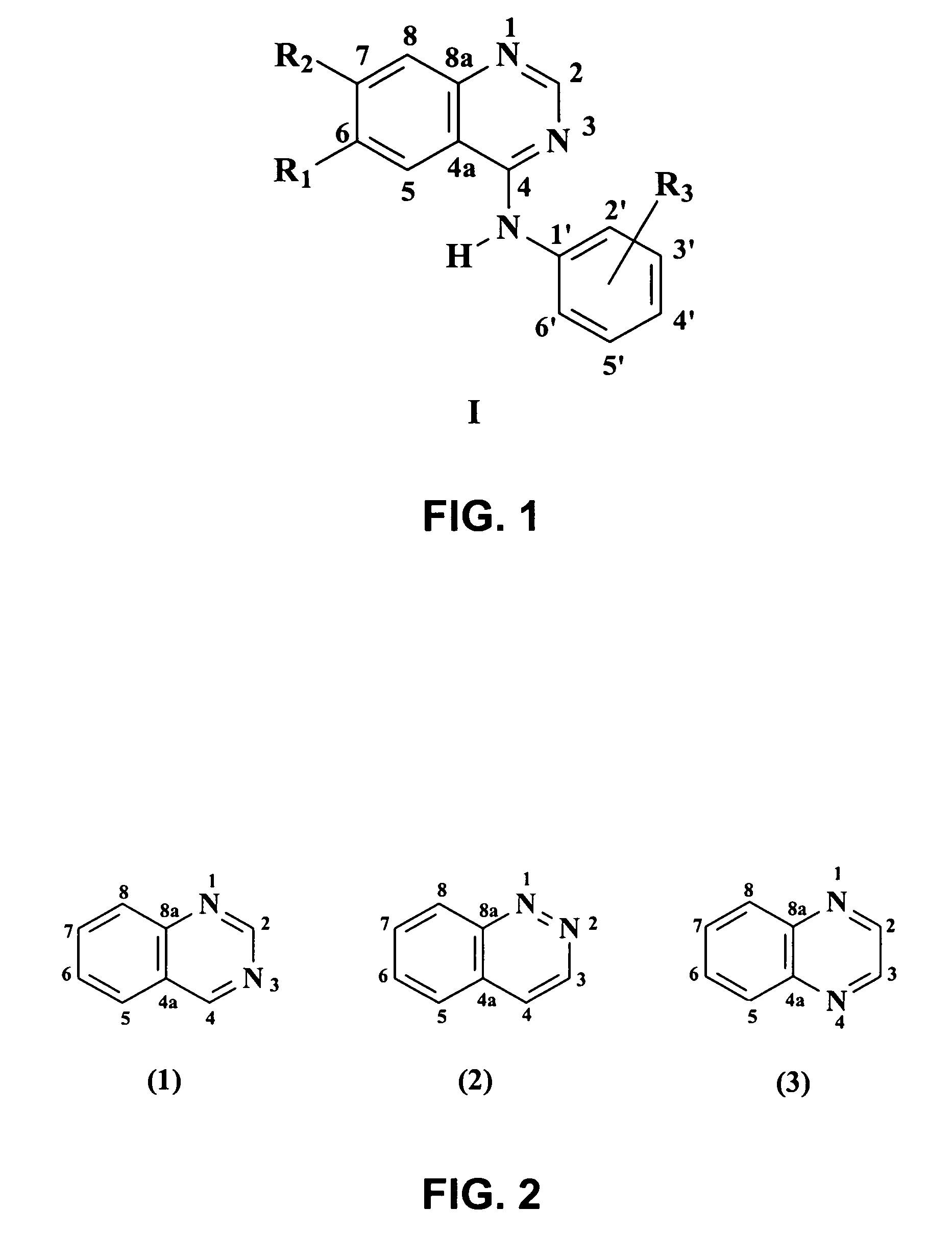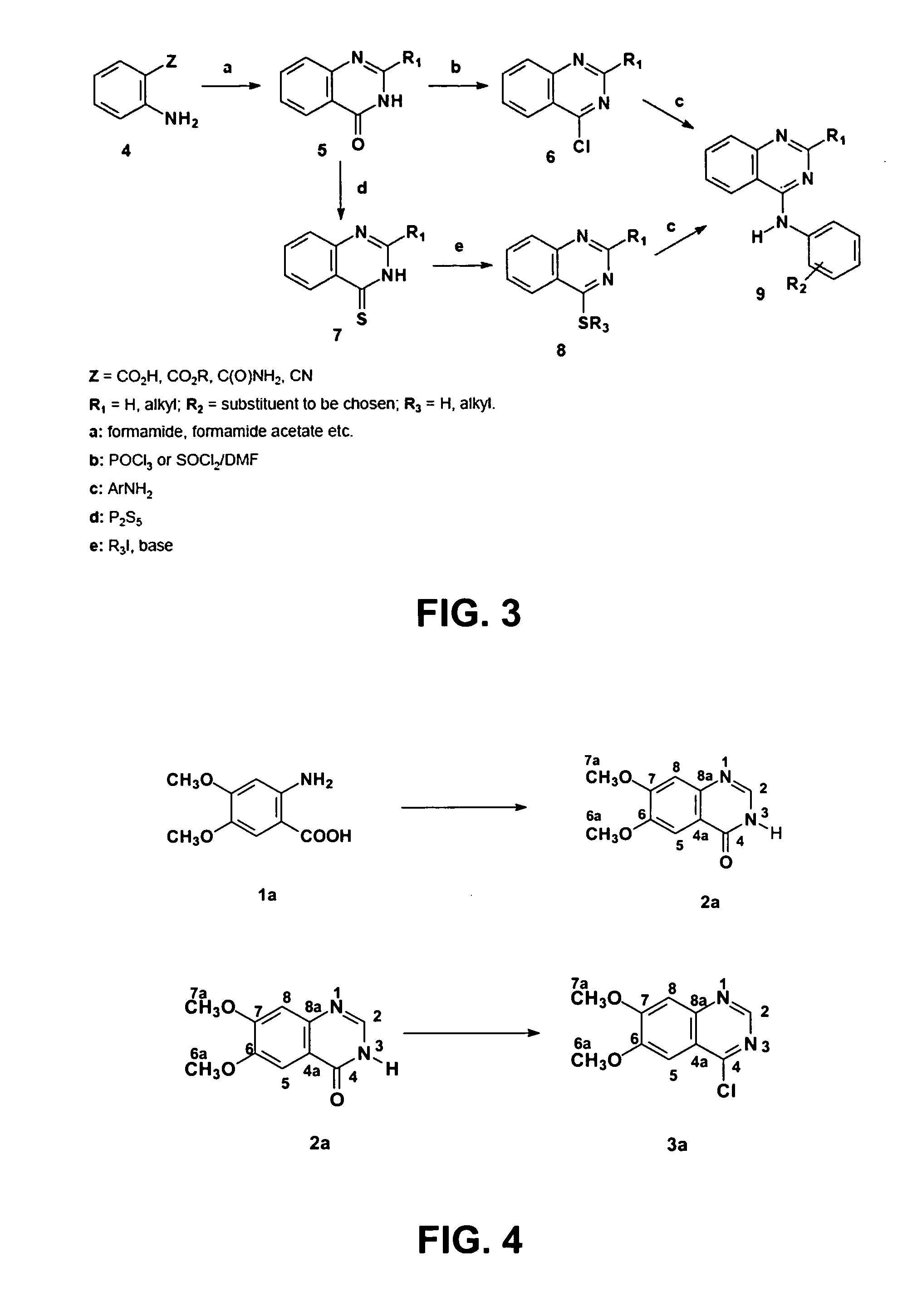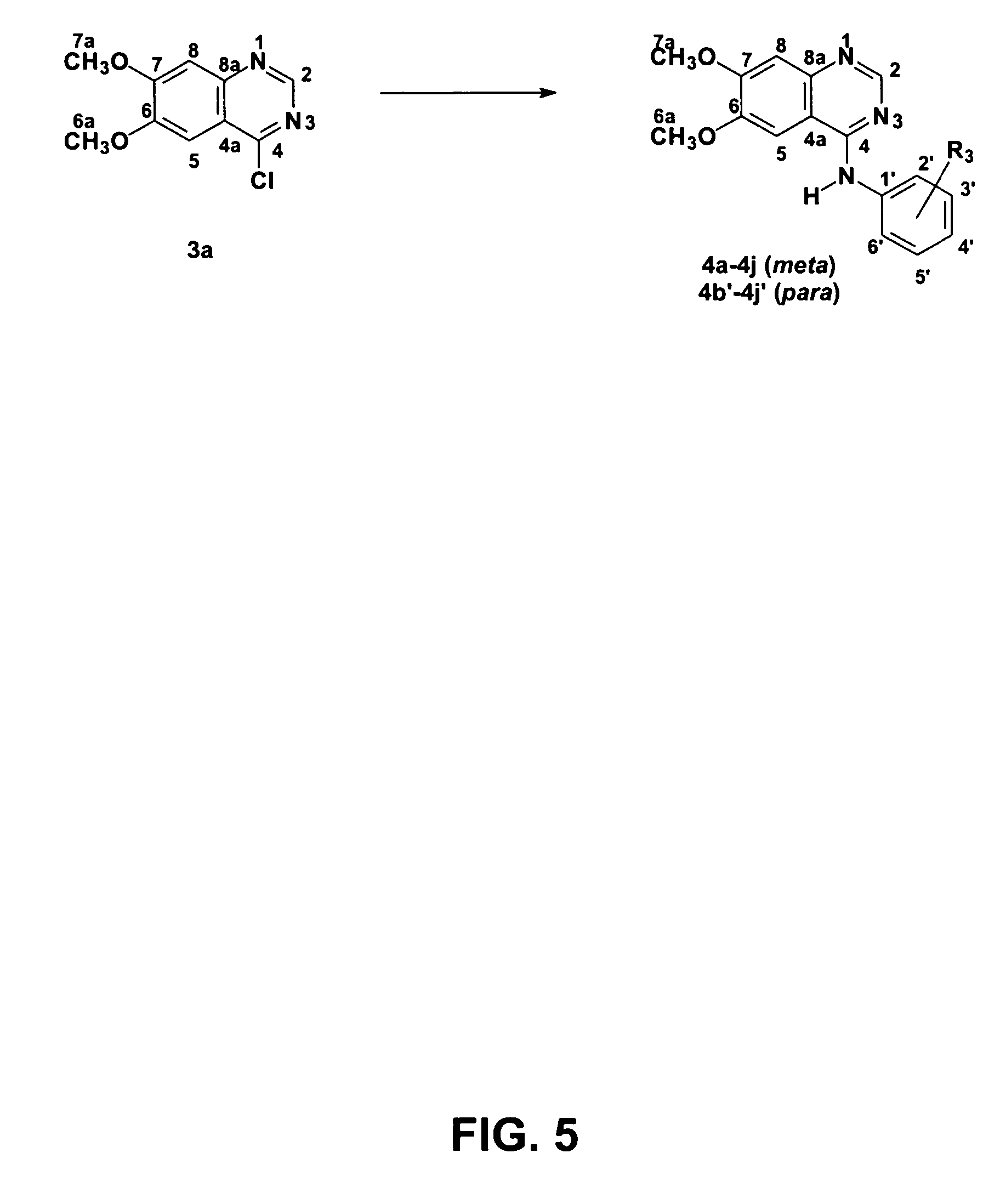4-anilinoquinazoline derivatives with adenosine-kinase inhibitor properties
a technology of adenosine kinase and derivatives, which is applied in the field of compound compounds, can solve the problems of limiting the use of adenosine itself as a therapeutic agent, causing additional deleterious effects, and poorly knowing the mechanism of reperfusion deleterious effects
- Summary
- Abstract
- Description
- Claims
- Application Information
AI Technical Summary
Benefits of technology
Problems solved by technology
Method used
Image
Examples
example 1
Obtainment of 6,7-dimethoxyquinazolin-4(3H)-one (2a)
[0088]A mixture of 2-amino-4,5-dimethoxybenzoic acid (1.0 g, 5.08 mmol) and formamidine acetate (4.50 g, 43.3 mmol) was disposed in a 50 mL ball. The solid mixture was heated at 140° C. in a silicone bath for eight hours. During heating, the fusion of solids happened, and then the resolidification of the reaction environment. The mixture was left cooling, and then a NaOH solution was added to it (0.33 mol.L−1) until pH was adjusted to 8. The grayish pink solid was collected through filtering in a Büchner funnel, washed with water (3×10 mL), and dried in vacuum to provide the desired compound (0.79 g, 3.83 mmol, 76%), which was used without purification in the next stage: m.p. 296-298° C. (Lit. (Bridges et al., J. Med. Chem. 1996, 39, 267), m.p. 295-298° C.).
[0089]1H RMN [500 MHz, (CD3)2SO, ppm]δ: 12.07 (1H, s, H-3), 8.00 (1H, s, H-2a), 7.45 (1H, s, H-5), 7.14 (1H, s, H-8), 3.91 (3H, s, H-6a), 3.87 (3H, s, H-7).
Obtainment of 4-chlor...
example 2
Obtainment of 6,7-Dimethoxy-4-(anilino)quinazoline hydrochloride (4a): Yield of 0.110 g (0.346 mmol, 77.0%), Melting Point 268-270° C. (Lit. (Bridges et al., J. Med. Chem. 1996, 39, 267) Melting Point>250° C.)
[0095]RMN of 1H [500 MHz, (CD3)2SO, ppm]δ: 11.46 (1H, s, NH), 8.80 (1H, s, H-2), 8.35 (1H, s, H-5), 7.70 (2H, d, 3J=8.0 Hz, H-2′ e H-6′), 7.50 (2H, t, 3J=8.0 Hz, H-3′ e H-5′), 7.38 (1H, s, H-8), 7.32 (1H, t, 3J=8,0 Hz, H-4′), 4.04 (3H, s, H-6a), 4.01 (3H, s, H-7a).
[0096]IV (KBr / cm−1) ν: 3418 (N—H), 3062 (C—H of an aromatic), 1635-1459 (C—N of an aromatic), 1459 (C—C of an aromatic), 1279 (C—O—C), 867-748 (C—H).
[0097]MS(EI), m / z (%): 281.1 (M+) (84.25), 280.1 (M−H)+ (100).
[0098]Elementary analysis for C16H15N3O2.HCl (%)—calculated: C, 60.48; H, 5.07; N, 13.22. Determined: C, 60.48; H, 4.92; N, 13.16.
example 3
Obtainment of 6,7-Dimethoxy-4-(3′-fluoroanilino)quinazoline hydrochloride (4b): Yield of 0.100 g (0.298 mmol, 67%), Melting Point 219-221° C. (Lit. (Bridges et al., J. Med. Chem. 1996, 39, 267) Melting Point 253-254° C.)
[0099]RMN of 1H [500 MHz, (CD3)2SO, ppm]δ: 11.51 (1H, s, NH), 8.86 (1H, s, H-2), 8.41 (1H, s, H-5), 7.74 (1H, dt, 3JH-F=11,0 Hz and 4JH-H=2,2 Hz, H-2′), 7.63 (1H, ddd, 3J=8.3 Hz and 4Jmeta=2.2 Hz, 4Jmeta˜1.0 Hz, H-6′), 7.52 (1H, dt, 3JH-H=8.3 Hz and 4JH-F=6.7 Hz, H-5′), 7.39 (1H, s, H-8), 7.15 (1H, tdd, 3JH-H=3JH-F=8.3 Hz, 4JH-H=2.2 Hz and 4JH-H=2.2 Hz and 4JH-H˜1.0 Hz, H-4′), 4.04 (3H, s, H-6a), 4.00 (3H, s, H-7a).
[0100]IV (KBr / cm−1) ν: 3412 (N—H), 3062 (C—H of an aromatic), 1635 (C—N of an aromatic), 1490 (C═C of an aromatic), 1279 (C—O—), 985 (C—F), 872-774 (C—H).
[0101]MS(EI), m / z (%): 299.0 (M+) (91.4), 298.0 (M−H)+ (100).
[0102]Elementary analysis for C16H14N3O2F.HCl (%)—calculated: C, 57.24; H, 4.50; N, 12.51. Determined: C, 57.14; H, 4.38; N, 12.34.
PUM
| Property | Measurement | Unit |
|---|---|---|
| size | aaaaa | aaaaa |
| sizes | aaaaa | aaaaa |
| structure-activity relationship | aaaaa | aaaaa |
Abstract
Description
Claims
Application Information
 Login to View More
Login to View More - R&D
- Intellectual Property
- Life Sciences
- Materials
- Tech Scout
- Unparalleled Data Quality
- Higher Quality Content
- 60% Fewer Hallucinations
Browse by: Latest US Patents, China's latest patents, Technical Efficacy Thesaurus, Application Domain, Technology Topic, Popular Technical Reports.
© 2025 PatSnap. All rights reserved.Legal|Privacy policy|Modern Slavery Act Transparency Statement|Sitemap|About US| Contact US: help@patsnap.com



